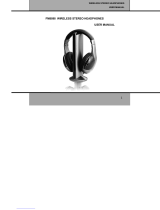
Important safety information
2
Important safety information
• Please read this instruction manual carefully and completely before
using the product.
• Make this instruction manual easily accessible to all users at all times.
Always include this instruction manual when passing the product on to
third parties.
• Do not use the product in situations which require special attention
(e.g. in traffic or when performing skilled jobs).
• Always keep the product dry and do not expose it to extreme
temperatures (normal operating temperatures: 0 °C/32 °F to 40 °C/
104 °F).
• Use the product with care and store it in a clean, dust-free
environment.
• Switch the headphones off after use to conserve battery power.
Remove the batteries if the product will not be used for extended
periods of time.
• The headphones contain magnets that generate a magnetic field which
could cause interference with cardiac pacemakers and implanted
defibrillators. Keep the headphones at least 1.2” (3 cm) from cardiac
pacemakers or implanted defibrillators.
• Please protect your hearing from high volume levels. Sennheiser
headphones also sound exceptionally good at low volumes.
• Only use the Sennheiser supplied power supply units.
• To reduce the risk of fire or electric shock, do not use the product near
water and do not expose it to rain or moisture.
• Unplug the power supply unit from the wall socket
– to completely disconnect the product from the mains
– during lightning storms or
– when unused for long periods of time.
• Only operate the power supply unit from the type of power source
specified in the chapter “Specifications” (see page 32).
• Ensure that the power supply unit is
– in a safe operating condition and easily accessible,
– properly plugged into the wall socket,
– only operated within the permissible temperature range,
– not covered or exposed to direct sunlight for longer periods of time
in order to prevent heat accumulation (see “Specifications” on
page 32).
• Do not operate the product near any heat sources.
• Only use attachments/accessories specified by Sennheiser (see
“Accessories and spare parts” on page 31).
























